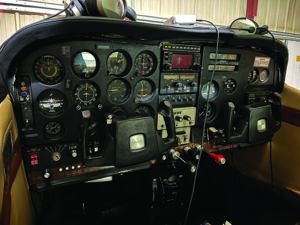This month’s Cessna Skylane panel for planning comes from Bruce Belling. Like lots of owners, he doesn’t have unlimited resources for a state-of-the-art avionics upgrade. While he’s content with the older equipment in his 182 (he also flies a G1000 airplane at work), he realizes it has aging stuff. A full-up glass makeover (Garmin G3X or Dynon HDX) isn’t out of the question someday—including engine and fuel displays and an autopilot upgrade—but the immediate plan is to use as much of the existing equipment as possible—including the round-gauge flight instruments.
The focus is in the main avionics stack where there are a few pieces of critical equipment that are long obsolete and starting to show signs of failure. Belling asked how many major systems need to fail before it would be cheaper to do a G3X Touch or Dynon HDX retrofit. That depends on budget. For this panel, that means dropping we’ll north of $60,000. But for south of $15,000, he might gain some reliability as a shorter-term solution, which also includes fixing minor issues on the panel.

SUPPORTABILITY MATTERS
That’s what you need to consider when nursing along old gear that doesn’t have factory support, and in Belling’s 182, two pieces of Narco equipment stand out. The digital Narco MK12 is actually a Cessna replacement navcomm radio that uses the existing ARC Cessna wiring and it drives the ARC OBS indicator.
With Narco long out to pasture, the radio is showing signs of frequency tuning failure. Maybe it’s a channeling IC, display assembly or the small components that drive the display circuitry. In any case, it’s likely not worth sinking much if any money into a bench repair attempt—if you can even find someone willing to work on it. Unfortunately, old-school bench techs who know this old equipment are retiring and passing away, so it’s a challenge to find shops that know how to fix old radios—if they can even source the parts.
If a secondary VHF navcomm is a necessity, I might consider Trig Avionics’ new TX56 series navcomm. It’s thinner than the Narco, so the stack would have to be reconfigured (not a bad thing since it’s time to ditch that big space-eating ARC ADF). The basic audio switching panel at the top is a King KA134 and it works fine.
The new Trig TX57 radio is the 28-volt version and is priced at $4800, not counting installation or a new OBS indicator. Trig does offer a standalone comm if you didn’t want a nav. Garmin’s navcomm is the GNC 255 priced at $5200 without an OBS indicator. It also offers a comm-only version. As we’ve reported ad nauseam, your buying decision (for a VHF nav or not) depends on how confident you are that you won’t lose the GPS signal when you need it the most.
Moving down the stack, the analog cavity-tube-driven Narco AT150 transponder catches my eye as a potential problem, and this one has an intermittent Mode C reporting problem. While that could be the blind altitude encoder, it could also be the Mode C circuitry inside the transponder. Garmin’s $2500 GTX 325 is one possible Mode A/C unit, as is the $2400 Sandia STX 165. We’ll look at replacement transponders in an upcoming issue of Aviation Consumer.
Worth mentioning is the Garmin GNS 430W in this Cessna’s stack. Garmin recently warned GNS owners to consider replacement options within a year or so because of planned obsolescence. But Belling’s GNS 430W is recently refurbished—a $1900 factory repair that I think makes sense for lots of owners who aren’t prepared for an upgrade. Display lens and bezel key replacement, plus receiver checks and other items addressed by Garmin, could give these aging units a new lease on life.
Got a panel that needs some planning? Drop us a line with good images of the current layout and we’ll take a look.


